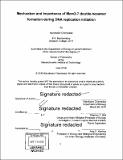| dc.contributor.advisor | Stephen P. Bell. | en_US |
| dc.contributor.author | Champasa, Kanokwan. | en_US |
| dc.contributor.other | Massachusetts Institute of Technology. Department of Biology. | en_US |
| dc.date.accessioned | 2019-10-11T22:00:12Z | |
| dc.date.available | 2019-10-11T22:00:12Z | |
| dc.date.copyright | 2019 | en_US |
| dc.date.issued | 2019 | en_US |
| dc.identifier.uri | https://hdl.handle.net/1721.1/122523 | |
| dc.description | Thesis: Ph. D., Massachusetts Institute of Technology, Department of Biology, 2019 | en_US |
| dc.description | Cataloged from PDF version of thesis. | en_US |
| dc.description | Includes bibliographical references. | en_US |
| dc.description.abstract | All cells must duplicate their genome completely and accurately in each cell cycle. Thus, DNA replication is a highly-regulated multi-step process that ensures the genome is duplicated only once per cell cycle. In eukaryotic cells, initiation of DNA replication begins with loading of two heterohexameric Mcm2-7 helicases around origin DNA during G1 phase. The two helicases are loaded in opposite orientations and interact with each other at their N-terminal domains to form a head-to-head "double hexamer". In S phase, the helicases are activated by helicase-activation proteins to initiate DNA unwinding. Importantly, this event is the committed step of replication initiation. Loading of two helicases in the head-to-head double hexamer ensures DNA unwinding on both sides of the origin and allows the assembly of bi-directional forks essential for complete DNA replication. Two Mcm2-7 helicases are loaded onto the DNA sequentially. | en_US |
| dc.description.abstract | The order of events during the first helicase loading has been established, but the mechanism of double-hexamer formation remains unclear. Because the two helicases interact at their N-terminal domains, these regions represent potential mediators of double-hexamer formation. This thesis outlines the potential mechanism and the importance of double-hexamer formation. A conserved motif within Mcm2-7 N-terminal region is required for stable double-hexamer formation and cell viability. Single-molecule analyses of Mcm2-7 containing a mutation within this motif indicated that this mutant form double-hexamer interactions briefly before the two hexamers come apart. Interestingly, after double-hexamer dissolution, the two mutant helicases do not form subsequent double-hexamer interaction. Both wild-type and the mutant Mcm2-7 exhibit double-hexamer interaction rapidly after the arrival of the second Mcm2-7. | en_US |
| dc.description.abstract | Together, these data support the model that double-hexamer formation is coordinated with loading of the second Mcm2-7. Finally, the requirement of the double hexamer during helicase activation was investigated using Mcm2-7 complex containing the mutant that inhibits double-hexamer formation. The double hexamer is not essential for recruitment of three critical helicase-activation proteins, but it is required for initial origin DNA unwinding. These findings identify a crucial motif for stable double-hexamer formation and suggest that DNA unwinding is the first step in replication initiation that requires double-hexamer form of the helicases. | en_US |
| dc.description.statementofresponsibility | by Kanokwan Champasa. | en_US |
| dc.format.extent | 147 pages | en_US |
| dc.language.iso | eng | en_US |
| dc.publisher | Massachusetts Institute of Technology | en_US |
| dc.rights | MIT theses are protected by copyright. They may be viewed, downloaded, or printed from this source but further reproduction or distribution in any format is prohibited without written permission. | en_US |
| dc.rights.uri | http://dspace.mit.edu/handle/1721.1/7582 | en_US |
| dc.subject | Biology. | en_US |
| dc.title | Mechanism and importance of Mcm2-7 double-hexamer formation during DNA replication initiation | en_US |
| dc.type | Thesis | en_US |
| dc.description.degree | Ph. D. | en_US |
| dc.contributor.department | Massachusetts Institute of Technology. Department of Biology | en_US |
| dc.identifier.oclc | 1121456289 | en_US |
| dc.description.collection | Ph.D. Massachusetts Institute of Technology, Department of Biology | en_US |
| dspace.imported | 2019-10-11T22:00:11Z | en_US |
| mit.thesis.degree | Doctoral | en_US |
| mit.thesis.department | Bio | en_US |
